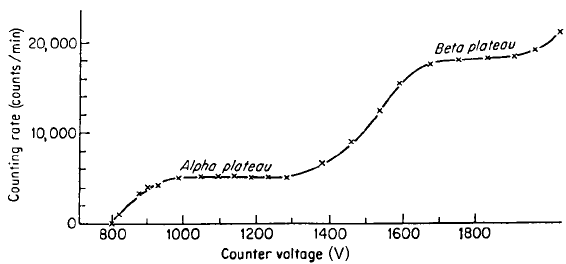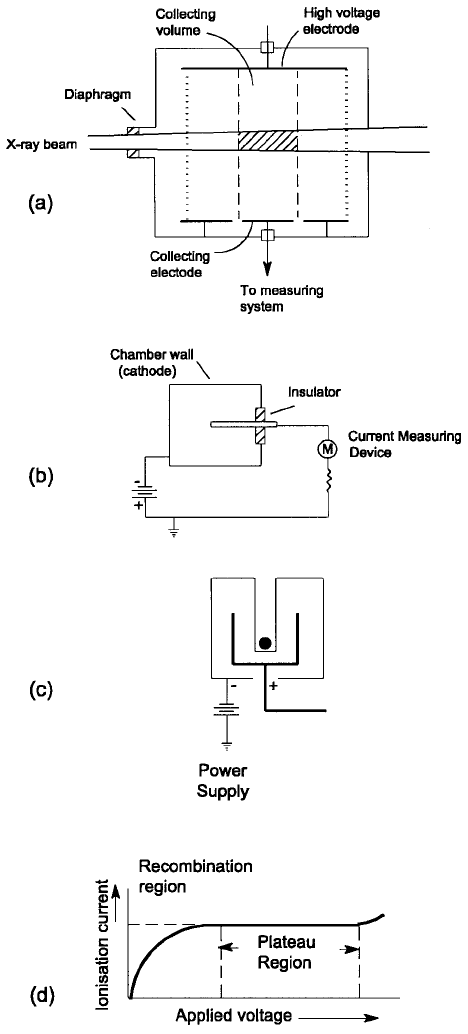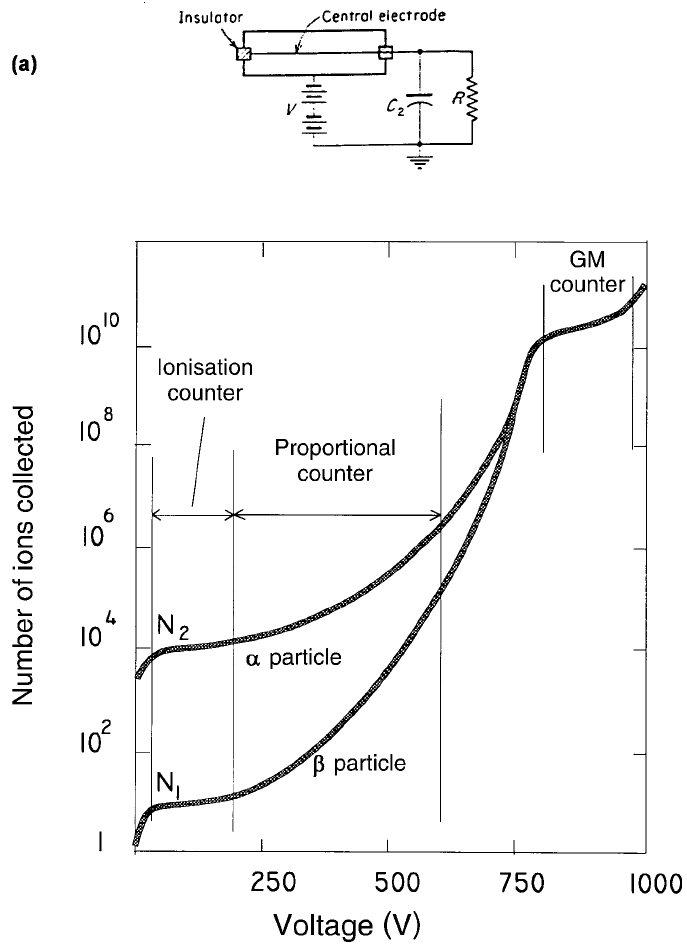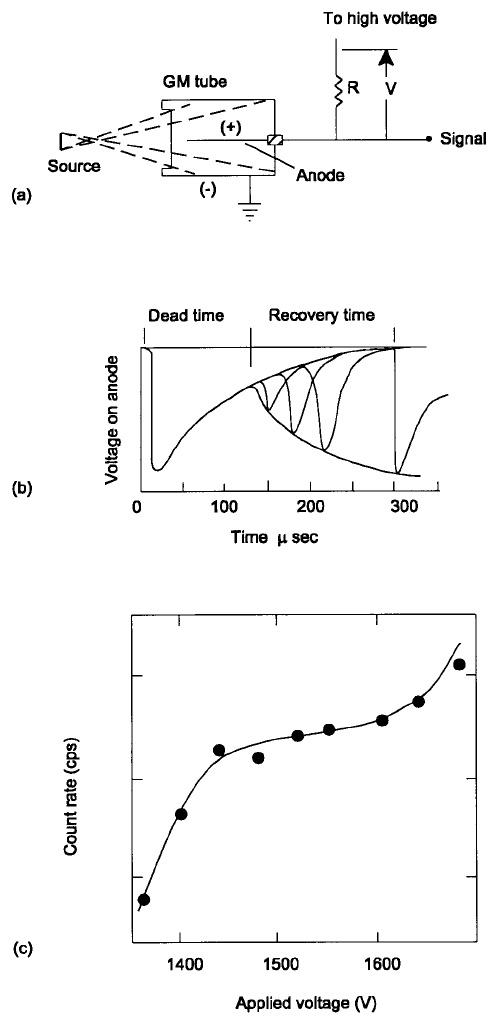Lowenthal G., Airey P. Practical Applications of Radioactivity and Nuclear Radiations
Подождите немного. Документ загружается.

With background g rays concentrated at energies around 100 keV (Figure
4.9), covering a g ray detector with just 5 mm steel or its equivalent (when it
remains easily portable) will cause a useful reduction relative to the
unshielded background rate. When working in open ®elds and especially over
water surfaces, the background rate could be two or more orders of
magnitude below what is observed in the average laboratory. However, the
background is relatively high near stone walls and especially so near deposits
of uranium, thorium or mineral sand in the ground, or near megavoltage
installations. Procedures to minimise background rates during low-level
counting using anti-coincidence methods were described in detail by Watt
and Ramsden (1964).
4.6.5 The alpha and beta particle background
Portable GM monitors used routinely as b particle detectors owe much of
their enduring popularity to their low background rate, rarely higher than
5 cps even without shielding. This is due mainly to their low g ray ef®ciency
(Section 5.3.2) and the fact that background radiations are mainly g rays
(Section 4.6.4). For the same reasons the background rate is similarly low
when working with proportional counters (Section 5.3.3).
Counts due to b particles or other electrons could be contributed by
radionuclidic impurities in the material of the detector or by cosmic ray
interactions and also by naturally occurring carbon-14 as
14
CO
2
, the supply
of which is kept up by cosmic ray interactions in the upper atmosphere. Other
b particle sources adding to the background are the long-lived tritium and
caesium-137 left in the atmosphere from nuclear testing during the 1950s and
1960s (Section 9.4.2). Shielding b particle detectors by lead bricks is likely to
reduce the background rate to a fraction of a count per second, which helps
to keep it suf®ciently reproducible, e.g. during comparisons of b particle
countrates in proportional counters.
Proportional counters set up for a particle counting are operated at a
lower polarising voltage than is required for the detection of b particles
(Figure 4.10). The unshielded background rate during a particle counting is
then unlikely to exceed 10 to 20 counts per hour, a small fraction of the
background rate when counting b particles because electrons that enter a
counter set up for a particle counting (e.g. those dislodged by g rays) are
`ignored'.
The few background counts in a particle detectors are principally due to
impurities which are naturally occurring a or b particle emitters, or to cosmic
radiations interacting with atoms of the detector material, with counts
4.6 Corrections and precautions, part 2 121

resulting on the rare occasions when charged particles are emitted near
enough to the inner surface of the counting chamber to permit them to reach
the chamber and be counted.
Nuclear radiations: a user's perspective122
Figure 4.10. The counting of a and b particles in a windowless proportional
counter at normal pressure. The a particle plateau begins just above 1000 V; the
plateau for b particles begins near 1700 V.
Chapter 5
Ionising radiation detectors
5.1 Radiation detectors, a summary
Ionising radiations as normally used cannot be observed by the unaided
human senses. They were discovered thanks to photographic emulsions
which remain important detectors to this day, particularly in the biological
sciences. There are many designs of detectors developed to respond to speci®c
characteristics of the different types of ionising radiations discussed in earlier
chapters and notably in Section 4.3.3.
Sections 5.2 and 5.3 will deal with ionisation detectors used for b and g
radiations, Section 5.4 will deal with liquid scintillation (LS) counting, adding
to the material presented in Section 4.2.4. This will be followed by a
description of microcalorimetry, an ef®cient detection method when working
with high activities of many b and g ray emitters. Section 5.4 will also cover
the detection of neutrons at low and high intensities. Section 5.5 will deal
with semiconductor detectors, which have long been indispensable for
photon as well as for charged particle spectrometry.
Readers who seek details about specialist applications in any branch of
radioactivity measurements are referred to the work of Knoll (1989), who
deals with the scienti®c principles underlying these procedures over a broader
range than other currently available textbooks.
5.2 Characteristics of ionisation detectors
5.2.1 Saturation currents and gas multiplication
A long established method for measuring the intensity of nuclear radiations
uses their ability to ionise air or other gases such as argon or methane.
Instruments that use an electric ®eld to collect the ions and serve to measure
123
the resultant ionisation current are known as ionisation chambers, but
ionisation detectors can also be operated as pulse counters.
When employed to detect g rays, ionisation chambers should preferably be
of several litres capacity. They will then have a satisfactorily high g ray
ef®ciency, especially when sealed and pressurised. Pulse counters are com-
monly small and serve principally for the detection of a and b particles and
also of neutrons.
Pressurised ionisation chambers measure ionisation currents due to activ-
ities of the order of 10
12
gammas per second and higher with reproducibilities
within 0.10%. The stability of their response is due to their simple construc-
tion and operating characteristics (Section 5.2.2). They are useful g ray
detectors even though they are insuf®ciently sensitive for measuring ionisa-
tion currents due to low g ray activities (<10
3
gamma rays per second) with
the lower limit depending on the average energy and intensity of the detected
photons.
Two types of radiation detectors which operate in the pulse mode are the
proportional counter and the Geiger±Mu
È
ller (GM) counter. A pulse counter
needs only three or four ion pairs due to a charged particle which entered its
sensitive volume in order to register a count with near 100% probability. This
is so because detection is effected using ion multiplication by collision which
is also responsible for the relatively long dead time of GM counters, setting a
limit to attainable countrates (Section 4.5.2).
5.2.2 Three saturation chambers
Figure 5.1(a) to (c) show schematic diagrams of three types of ionisation
chambers used in the saturation region for X or g ray detection. They can be
used open to the atmosphere because they can tolerate electro-negative gases
such as oxygen which must be excluded from pulse counters (Section 5.3.3).
The dimensions and other characteristics of commercially supplied chambers
will be described in Section 6.3.2.
At low polarising voltages most ions formed by ionising radiations
recombine before they can be collected. It is only when the voltage reaches
the saturation level that it collects all ions to form the saturation current,
which then remains constant even though the voltage is increased by another
200 to 300 V as shown in Figure 5.1(d). It is normal practice to operate
saturation chambers at a voltage near the middle of the plateau. The voltage
required to reach saturation depends slightly on the activity of the source;
this should be borne in mind when working with both high- and low-activity
sources.
Ionising radiation detectors124

5.2 Characteristics of ionisation detectors 125
Figure 5.1. (a) to (c) Three designs of ionisation chambers operated in the
saturation region. (d) A plot of ionisation current versus applied voltage showi ng the
recombination and saturation regions. The plateau could extend over 300 V or more.
Assuming one measures a long-lived radionuclide, the saturation current
remains constant as long as the applied ®eld is suf®ciently strong to collect all
ions formed in the gas but not strong enough to accelerate ions to speeds
where they have enough kinetic energy to ionise gas molecules. If this
happens the ionisation current is increased beyond the saturation level so
causing errors.
5.2.3 Parallel plate and cylindrical chambers
Parallel plate chambers open to the atmosphere are now only used for a few
specialist purposes, e.g. for the measurement of exposure (Figure 5.1(a) and
Section 2.4.2). The preferred type for the detection and measurement of X
and g rays is the sealed, cylindrical chamber where a relatively small diameter,
hollow cylindrical anode which holds the radioactive source is surrounded
co-axially by the cathode. In routinely used chambers, the anode (Figure
5.1(c)) is made of between 0.3 and 0.5 mm steel tubing which transmits
photons down to about 15 keV with suf®ciently small attenuation.
Sealed chambers permit the use of gases other than air and at above
atmospheric pressure, so increasing the sensitivity of the measurements
(Section 6.3). Also, the cylindrical geometry of the electrodes ensures that the
electric ®eld strength increases towards the smaller diameter anode (Eq.(5.1)).
This arrangement results in a high ef®ciency for these chambers, as does the
near 4p geometry. Both of these factors also ensure a high reproducibility of
the results of measurements.
Ionisation currents caused by radionuclides in pressurised ionisation
chambers cover a large range ± from a few milliamperes measurable with
routinely used current meters down to levels comparable with leakage
currents which can be below 10
714
A in well maintained high-quality
instruments (Section 6.3.4). Leakage currents set the limit to the accuracy of
ionisation current measurements due to the radioactive source.
5.3 Proportional and Geiger±Mu
È
ller counters
5.3.1 Thin wire counters
Operating principles
Figure 5.2(a) shows an ionisation chamber of the design used for pulse
counters. The anode is a thin metal wire, commonly 0.02 to 0.1 mm diameter
tungsten. Such thin wires have high electric ®elds at their surface even for
Ionising radiation detectors126

5.3 Proportional and GM counters 127
Figure 5.2. (a) A schematic diagram of a thin wire ionisation detector. (b) Number s
of ions collected per unit time in a thin wire counter as a function of the applied
voltage when the primary ions are generated by a and b particles in the ratio 10
3
to 1.
The three operating regions are indicated, though the plateau in the proportional
region (Section 5.3.3) cannot be shown here.
(b)
relatively moderate applied voltages. These ®elds trigger ion multiplication
by collision and characterise the operation of these instruments, usually GM
and proportional counters.
Figure 5.2(b) shows a plot of ionisation intensities due to the number of
ions collected (note logarithmic scale) in these chambers (per unit time) as a
function of the applied voltage. Following the ¯at saturation region labelled
ionisation counter, there is the onset of ion multiplication by collision leading
to the proportional region followed by the steep increase towards the Geiger
region. The two curves labelled b particle and a particle are here assumed to
differ in ionisation intensity by a factor of 10
3
. This ratio is preserved
throughout the saturation and proportional regions but goes down to unity
in the GM region.
Although not evident in Figure 5.2(b), the proportional region permits the
establishment of a counting plateau, commonly 200 V to 300 V long, with a
slope within 0.5% per 100 V. The Geiger region also permits the formation of
a counting plateau (Figure 5.3(c)) though it is shorter (<200 V) and less ¯at (2
to 4% per 100 V) than the plateau in the proportional region. This is an
important reason why proportional counting is signi®cantly more accurate
and reproducible than GM counting.
A typical GM detector is shown in Figure 5.3(a) and a windowless 4p
proportional counter is illustrated in Figure 6.1(a). The normally used
detection medium in sealed GM counters is argon±10% ethyl alcohol at
about 10% of atmospheric pressure. The counters are sealed with metallised
Mylar windows made thin enough to transmit charged particles with energies
down to a few electronvolts.
Proportional counters such as that shown in Figure 6.1(a) are operated at
atmospheric pressure, but can be used, sealed and operated at much higher
pressures though this requires a correspondingly higher voltage to reach the
plateau. The 4p sources used in proportional counters (Section 5.3.3), can be
made two orders of magnitude thinner than the windows of GM counters,
this being another reason why proportional counters are the more ef®cient b
particle detectors.
Ion multiplication by collision
This process is responsible for the operation of both GM and proportional
counters. It is only in the very small volume, very close to the surface of the
wire anode that the electric ®eld is strong enough to cause ion multiplication
by collision, so making the response of these counters effectively independent
of the region where the ions were created, which is an essential requirement.
The electric ®eld strength E
r
at radius r mm from the axis (i.e. the centre
Ionising radiation detectors128

5.3 Proportional and GM counters 129
Figure 5.3. Three schematic diagrams illustrating the performance of GM detec-
tors. (a) The detector and its signal processing circuit. (b) The electric ®eld at the
surface of the anode immediately following a count. (c) A GM plateau for a 5 cm
diameter tube.
line of the thin wire) of a cylindrical detector (Figure 5.2(a)) and subject to an
applied voltage V, is given by:
E
r
= V/[r ln (b/a)], (5.1)
where b and a are the diameters of the cathode and anode respectively.
Assuming V = 1000 V, a = 0.02 mm and b = 25 mm, the ®eld strength at
0.011 mm from the axis of the anode wire (0.001 mm above its surface)
would be 1000/[0.011 ln (25/0.02)] & 12 750 V/mm. At 0.2 mm from the axis
of the anode, E
r
is equal to 1000/[0.21 ln (25/0.02)] & 670 V/mm, or only
about 5% of the ®rst value.
5.3.2 The Geiger±Mu
È
ller counter
The GM tube (invented by H. Geiger in 1908) is a simple and relatively
cheaply constructed instrument. It generates pulses of a volt and higher with
close to 100% probability when a charged particle produces no more than
three or four ion pairs in the detector. These pulses are high enough to be
detected without prior electronic ampli®cation, a fact which simpli®es the
operation of these counters and reduces their cost.
When the Geiger plateau has been reached (Figure 5.2(b)), the tube not
only produces readily detectable output pulses, but does so regardless of the
number of ions responsible for triggering the counter. This is the reason why
GM counters cannot be used to measure particle energies. In contrast,
proportional counters can serve to measure b particle energies which can be
the higher, the higher the gas pressure in the counter.
When the GM detector has been triggered, ion multiplication by collisions
leads to intense ionisations and excitations in the counting gas at the surface
of the thin anode wire, so reducing the electric ®eld along the wire to near
zero (Figure 5.3(b)). The situation is controlled by the ethyl alcohol in the
counting gas, acting as a quenching agent which absorbs the very high
concentration of ions and photons along the anode. Ef®cient quenching
permits the electric ®eld in small tubes (~10 mm diameter) to recover within
100 ms. Larger tubes (>25 mm diameter) could require over 200 ms with a
correspondingly long dead time (Section 4.5.2).
GM detectors can be purchased with separate signal processing equipment
including a dead time gate, so allowing users to adjust the polarising voltage
and dead time as required for an application (Figure 4.2), e.g. in under-
graduate laboratories. Most GM detectors are sold as radiation monitors,
with just an on±off switch and a range switch for the scaler and a control
button to verify the voltage setting at some value between 300 and 800 V,
Ionising radiation detectors130
